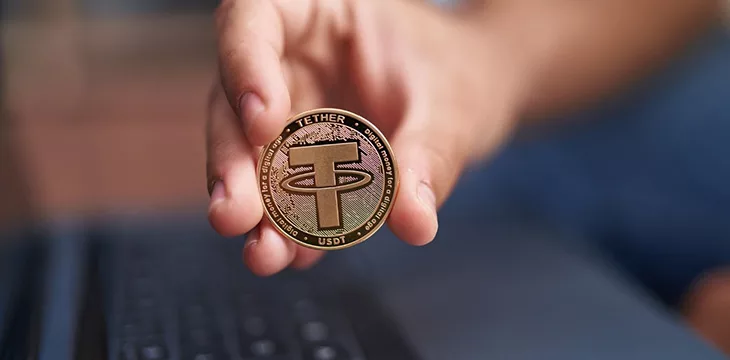|
Getting your Trinity Audio player ready...
|
The feud between stablecoin issuers Tether (USDT) and Circle (USDC) shows no sign of abating, while Circle’s partner, Coinbase (NASDAQ: COIN), appears to have a newfound appetite for risky business.
This week, Circle’s chief strategy officer Dante Disparte went on Bloomberg Crypto to discuss all things stablecoin, including PayPal’s (NASDAQ: PYPL) recent launch of its PYUSD dollar-denominated offering. Disparte had nothing but kind words for PayPal’s stablecoin entry, suggesting that consumers would benefit from healthy competition in this space.
But Disparte was less charitable when asked about Tether, which he likened to an “unsafe, opaque” financial option that was encouraging the overseas flight of U.S. capital. Disparte referenced a recent tweet thread by Circle boss Jeremy Allaire discussing the “clear risks of holding value in products with no known or widely available banking and highly opaque operations.”
Disparte restated Circle’s support for stablecoin-focused legislative efforts on Capitol Hill, asking “should anyone anywhere be able to counterfeit U.S. dollars using cryptographic methods or should there be a rule-set around competing with digital dollars as a base currency on the internet where the safety, soundness, and monetary policy of the United States and other financial integrity rules are respected?”
USDC’s current market cap of around $26 billion is only half its total from last year at this time. Asked about what might reverse this decline, Disparte cited a laundry list of initiatives that utterly ignore the fact that USDC’s current appeal serves as exit liquidity for those holding USDT.
As much as USDC’s cap has shrunk, Tether’s has grown by an almost identical amount over the same period and currently hovers around $83 billion. But redeeming USDT for actual dollars has always been a tricky affair, given that Tether may or may not have the money.
Enter USDC, which, unlike Tether, still enjoys access to U.S. banks. So individuals/entities trade their USDT for high-profile tokens such as BTC, then trade those tokens for USDC, which are then sent to Circle for redemption and conversion into cold hard cash. Circle has become an unwilling partner in this charade, its influence and prominence shrinking alongside USDC’s market cap.
Coinbase recently announced the official launch of its Canadian subsidiary but quickly followed that announcement with a warning that Canadian exchange customers would lose the ability to trade USDT (also the RAI and DAI stablecoins) as of September 1. Customers can still withdraw or deposit USDT after that date but can’t exchange them for other assets on the exchange.
While it’s tempting to view this as Coinbase attempting to push back against the Tether bullies, the reality is that Ontario, Canada’s largest province by population, prohibits exchanges from trading USDT. This restriction has led many companies to ditch Canada altogether, including Binance.
Base: the Layer 2 for screwing you
Getting back to USDC, its shrinking market cap is an existential threat to Coinbase, which has come to rely on interest income from using the dollars backing USDC to buy high-interest U.S. treasuries. So as USDC’s cap shrinks, so does Coinbase’s revenue.
Perhaps that’s why Coinbase appears increasingly interested in revenue opportunities that others might consider unethical or even unlawful. Consider Base, the exchange’s proprietary Layer 2 on the Ethereum network. It soft-launched in February, opened to developers in July, welcomed users last week, and has already proven fertile ground for opportunistic scammers.
Earlier this month, a new Base project called BALD—named after Coinbase CEO Brian Armstrong’s hairless dome—stole over $5 million from speculators who unwisely offered up their ETH tokens for a chance to go ‘to the moon.’
This week, a Solidus Labs report claimed to have identified “more than 500 scam tokens” on Base. Of these, 300 featured smart contracts containing functions allowing their developers to mint an unlimited number of new tokens. Another 70 had the ability to secretly modify transaction fees, while 60+ others prevented users from selling tokens after purchase.
Coinbase’s response amounted to a shrug and a meek caveat emptor warning, like, we’re just hosting this party; don’t blame us if someone puts fentanyl in the punchbowl. Coinbase is still mulling how to monetize Base, but hopefully, some kind of contingency fund is set aside to deal with the increased havoc their unnecessary creation has wrought on its customers.
Back to the futures
On Wednesday, Coinbase received approval from the National Futures Association (NFA) for Futures Commission Merchant status. The designation will allow Coinbase to offer ‘crypto futures’ to eligible U.S. customers when its new product launches in a month or so.
While Coinbase trumpeted the news as a “watershed moment,” investor enthusiasm was short-lived, with the result that the company’s share price closed Thursday down around 7% since the week began. The shares briefly fell below $72 in after-hours trading, down from over $110 in mid-July in the irrationally exuberant aftermath of institutional BTC ETF applications that listed Coinbase as a partner.
It doesn’t help that companies such as the Chicago Mercantile Exchange and LedgerX are already offering ‘crypto’ derivatives under similar permits to the one Coinbase just received or that U.S. traders simply aren’t as enthused about cannonballing into the ‘crypto’ pool as they were a few years ago.
At any rate, it’s not like Coinbase really needs to add yet another function to its already overtaxed ecosystem. Particularly given recent revelations as to how this multi-headed Hydra may impact its end users.
Enter at your own risk
One year ago, the Wall Street Journal reported on Coinbase Risk Solutions (CRS), a new unit consisting of “senior Wall Street traders” who were tasked with speculating on digital assets using Coinbase’s funds on Coinbase’s behalf.
Coinbase execs, who previously told Congress that the company doesn’t operate a proprietary trading business, responded to the WSJ report by saying, sure, we sometimes buy crypto but only to manage risks and participate in protocols.
CRS remains an ongoing concern, with recent job postings for traders and structurers. CRS is managed from Singapore, where Coinbase also offers exchange services to local customers. The two entities share a physical address.
Last year, Coinbase insisted that it didn’t trade against its exchange customers, saying “our incentives and our clients’ incentives are aligned by design.” Still, Coinbase describes CRS as “responsible for creating structured yield and access products for Coinbase’s institutional and crypto-native clients.” But what about Coinbase’s retail clients?
With the two branches of the same company operating under the same roof, how can they guarantee that one side isn’t glancing at the other side’s order books, particularly when the trading desk is under pressure to make a bank for the struggling parent company?
Recall that the U.S. Securities and Exchange Commission (SEC) civil suit against Coinbase was in part based on its failure to register as an exchange, broker, and clearing agency, as required by the Exchange Act and the Securities Act. Add a de facto hedge fund to that mix, and you can understand why Coinbase chose to base CRS outside America.
Also, recall that the civil suit filed against rival exchange Binance by the U.S. Commodity Futures Trading Commission (CFTC) included the allegation that Binance used around 300 “house accounts” controlled by founder Changpeng ‘CZ’ Zhao to trade against its own customers.
And finally, recall that the last time an exchange and a quant-laden trading group shared an office, it didn’t end well.
Cash poor
We’ll close on a few ominous items regarding Tether, whose most recent ‘attestation’ of the reserves allegedly backing those $83 billion worth of USDT showed only $90 million in cash as of June 30, down from $481 million as of March 30 and $5.3 billion at the end of 2022. Tether says it’s been spending cash to buy more U.S. Treasuries, but this is a company that treats lies like oxygen, so whatever.
Blockchain sleuths recently detected a transfer of $150 million of USDT to Tether from a wallet on the Bitfinex exchange, which shares ownership DNA with Tether. Within minutes, nearly the same dollar amount of BTC was sent to Coinbase in two transactions. It’s been suggested that this means Tether no longer has sufficient cash to meet redemption requests, forcing it to dip into its (alleged) stash of $1.7 billion worth of BTC.
Why Tether would choose to liquidate BTC rather than dip into its (alleged) $8.9 billion worth of overnight reverse repo agreements is anyone’s guess. That is, unless Tether knew in advance that this week’s abrupt crash in the fiat value of BTC was coming, which raises a whole host of other questions.
China Evergrande, the real estate mega-developer that was long suspected of being the source of Tether’s commercial paper holdings, filed for bankruptcy protection on Thursday. Some major Chinese financial firms are also flirting with bankruptcy, fueling existing fears about the health of the broader Chinese economy. China’s underground economy has long relied on USDT, particularly to evade the country’s strict capital controls.
Meanwhile, Tether announced Thursday that it was “discontinuing support for the Kusama, Bitcoin Cash SLP, and Omni Layer implementations.” Tether described the Omni move as notable, given it served as USDT’s “first transport layer” in 2014, but it and the other two protocols no longer meet Tether’s exacting standards of popularity.
Tether said it will continue to redeem the USDT held on these three platforms “for at least the next 12 months.” However, keep in mind that Tether sets a minimum US$100,000 threshold for even acknowledging (let alone acting on) redemption requests, so unless you’re a Tether whale, your options are limited.
Tether says users can swap their marooned USDT “for other chains on platforms that support these assets, such as Bitfinex.” That is, assuming you’re willing to submit yourself to Bitfinex’s rigorous ‘know your criminal, er, customer’ identification process. If, for whatever reason, you’re averse to such scrutiny, well, that’s just fewer fake dollars Tether has to list on its books, isn’t it?
Follow CoinGeek’s Crypto Crime Cartel series, which delves into the stream of groups—from BitMEX to Binance, Bitcoin.com, Blockstream, ShapeShift, Coinbase, Ripple,
Ethereum, FTX and Tether—who have co-opted the digital asset revolution and turned the industry into a minefield for naïve (and even experienced) players in the market.

 05-09-2025
05-09-2025 





